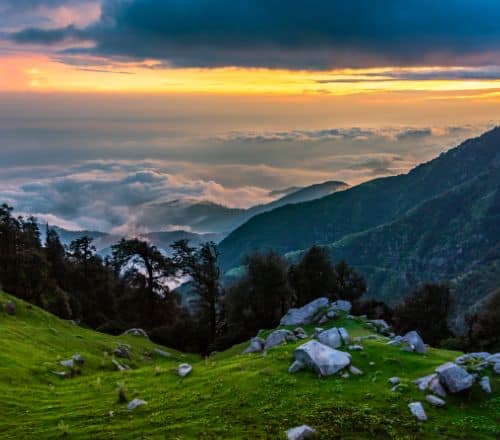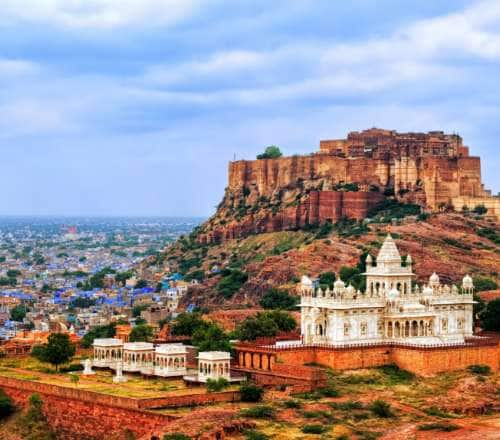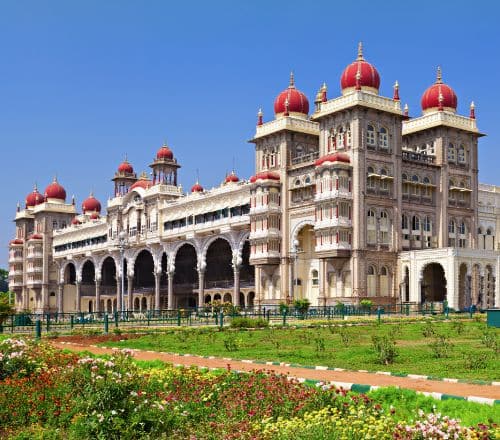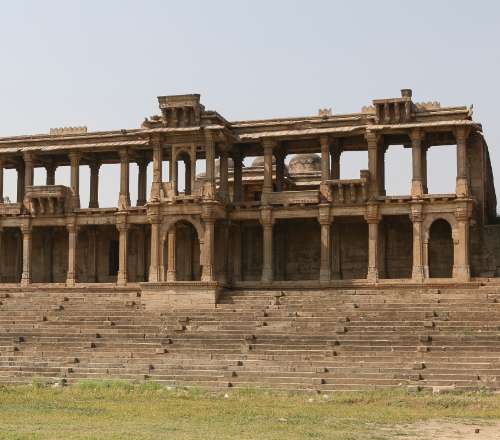Stay logged in to proceed with bookings, orders and offers.
On changing the terminal, you will loose items in your cart. Are you sure you want to change your terminal?
Exploring a quaint little corner of South Bombay
South Mumbai gives you a feeling unlike any other. When you are in this part of the city, you are constantly reminded of how glorious Bombay once was. Here, you can still spot the history that made up the city's sweeping boulevards, seaside promenades, grand hotels, grassy maidans, and formidable monuments. Even today, this southernmost tip of the city carries an air of nostalgic magnificence.
Read More
Read Less
Kala Ghoda was named after a statue of King Edward VII. Captured in bronze, he sat atop a massive horse in full military attire. A wealthy Sassoon family gifted the equestrian ode to royalty to the city in 1879, and it was initially placed at a prominent junction. The horse was later polished to a dull black finish, hence the name Kala Ghoda. And Bertie (as the King was colloquially known) continued to lord over this little corner of his kingdom for years.
Fast forward several years post-independence and the consensus was that the statue was an unpleasant reminder of the city’s colonial past. It was uprooted and re-installed in the leafy environs of the Bombay Zoo where it stands today. Kala Ghoda had no horse for the longest time, but the name had already stuck. In 2017, citizens and local cultural groups reinstated a new sculpture, a riderless horse, at a parking lot in the neighbourhood’s epicentre. The 'Spirit of Kala Ghoda' now stands strong over the cafes, art galleries, and educational institutes.
Make your way through South Bombay - from the organised ranks of Navy Nagar and the shopping crescent of Colaba Causeway - and you reach a small swathe of the city, one that changes drastically in terms of architecture and open spaces. Flanked on one end by the vast Chhatrapati Shivaji Maharaj Vastu Sangrahalaya, this cultural and educational hub extended to the Mumbai High Courts and the Oval Maidan on opposite sides. Welcome to Kala Ghoda. Welcome to the neighbourhood of the Black Horse.
Regal Cinema
We start our escapade at the Regal Cinema. The theatre's charm may have faded over the years for the 80s child in me, but nothing can beat the memory of watching the curtains part with a messy chicken mayo roll in one hand and an orange ice candy in the other. Regal still screens Bollywood and Hollywood blockbusters, and the wide arc of the balcony seats and the velvet-draped stage remains regal and impressive.
Chhatrapati Shivaji Maharaj Vastu Sangrahalaya
The erstwhile Prince of Wales Museum opened to the public in 1922. With over 50,000 exhibits that include collections of art, porcelain, jewellery, and even a natural history section, you can spend hours within its cool marble interiors. Open daily between 10am and 6pm (except for a few public holidays), and ticket prices vary for locals, tourists, children, senior citizens and defence personnel. Extra charges apply if you plan to carry a tripod or a video camera.
The Jehangir Art Gallery and the NGMA (National Gallery of Modern Art) are the two largest art galleries in Kala Ghoda. Over the years, the galleries have hosted countless art exhibitions and displayed works of legends such as MF Husain and SH Raza. Entry is free and you can visit between 11 am to 7 pm daily.
Jehangir Art Gallery was a regular hangout when we were in college. I miss when Samovar, the arty cafeteria at Jehangir, used to be our adda! Back then, a glass of cool kala khatta and a plate of the delectable aloo paratha was just the sustenance we needed. With our tummies fear, we would return to the David Sassoon Library, and hit the books again, risking dozing off between pages.
As you meander through the maze of tiny streets that radiate from the iconic statue, you notice a blue building. Once a pale Wedgewood blue, it was recently painted striking indigo with white trimmings. This is the Knesset Eliyahoo Jewish Synagogue built in 1884 by the same wealthy Sassoon family to cater to the Baghdadi Jews who had stayed in Mumbai. Today, the number of Jewish families has dwindled and the synagogue threw open its door to all visitors.
The bylanes of Kala Ghoda are a veritable treasure trove for foodies like me. First off, there's Trishna - a Mumbai institution known for its delicious seafood. Go there for a weekend lunch and order a plate of prawn koliwada and a pitcher of cold beer. Perfection!
The quaint foyer of Kala Ghoda Cafe lies opposite Trishna. White-washed walls and wooden cafe furniture beckon you to feast on a menu filled with healthy treats and not-so-healthy Parsi delicacies. If it's a hot day, get a chilled glass of lemon espresso and sip it slowly while eavesdropping on the delightful conversations around you.
Americano is one of my all-time favourite restaurants in the city. Order the Americano Roast Chicken Meal served with sourdough stuffing and salsa verde and top off your gorgeous meal with handmade pistachio gelato. Chef’s kiss! Reservations are notoriously hard to come by. Plan ahead.
If you visit the Fab India store (and you definitely should), make a pit stop at their charming in-house Fab Cafe. Serving healthy snacks and mini-meals, it's a lovely spot for a quick meet-up with friends. Enjoy their vegan cold coffee and a plate of ‘no-guilt golgappas.’ Fab Cafe is open daily from 10 am to 10 pm and makes for an excellent breakfast spot.
Apart from these regular haunts, there are cafes such as Sequel for organic meals and drinks, Punjab Grill for north Indian crowd pleasers, Rue de Liban for a Lebanese/Mediterranean fix and La Folie for exquisite chocolates and pastries.
With the gradual gentrification of Kala Ghoda and its surroundings, a slew of bridal boutiques, custom-made shirt stores, and trendy designer studios have made the neighbourhood their home. Don't forget to pop into Westside next to the David Sassoon Library. It’s always a pleasure to shop in this well-lit, spacious department store. With three floors and a Starbucks outlet within, you can make a hefty dent in your credit card with their trendy and affordable designs.
PS: Snag the beautiful handcrafted wooden trays or beaten metal candle stands from the Homeware section. They make fabulous gifts.
New shops aside, Kala Ghoda will always be Rhythm House - the coolest music store in Mumbai. I remember the hours at Rhythm House sifting through piles of records (which later became racks of CDs). When we used to visit with my parents, there were listening booths where you could try out the record before purchase. As a child, I used to tap along with my father, leisurely listening to his chosen stack of LPs. As a college student, visiting South Bombay always included a visit to Rhythm House. Closed for a few years now, the facade and signage remain. But I have heard rumblings about a re-opening. Wishful thinking it may be, but I wait eagerly nonetheless.
On the first week of every February, the Kala Ghoda precinct bursts into a happy array of colours and sounds. What began in 1999 as an event to celebrate art and culture, is now a mammoth nine-day extravaganza. The year 2023, marked the post-pandemic return of the festival. The committee prepared to entertain, educate, and feed over 1.5 lakh visitors with art exhibitions, theatre and dance performances, panel discussions, street installations and food stalls.
There’s a timelessness to Kala Ghoda that cannot be denied. I asked my friend Fayeza Hafizee who also works for Khaki Tours about why she loves the neighbourhood. She succinctly summarised my feelings with her reply, "I love taking the Kala Ghoda walks. There's so much history everywhere you turn. My favourite fact is that Dr Ambedkar used to regularly occupy a table at the Wayside Inn (which sadly doesn't exist anymore). Rumour goes that's where parts of the Indian Constitution were written."
Kala Ghoda is a living history lesson waiting to be read.





The Adani One expressly disclaims all liability, direct and indirect, in respect to actions taken or not taken based on any or all the contents of this Blog. The Blog is an opinion of the contributor based on the collation of data from various sources and is provided only for information purpose. Adani One does not canvass, advertise, solicit, invite or induct for any product, merchandise, information, brand or any other materials mentioned in the Blog, nor does it obtain any monetary benefit from the same. Reader is advised to read and apply his/her intellect and discretion in this regard. Any Intellectual Property mentioned in this blog belongs to the rightful owner. We do not intent to claim any interest over the same.